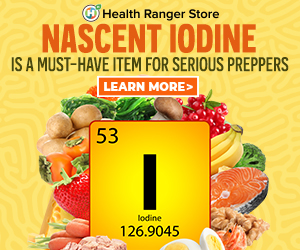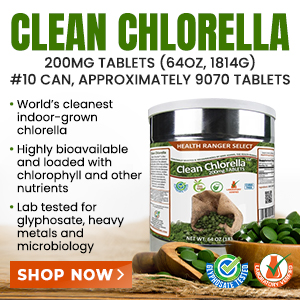
Supplements of DIM Stop Many Cancers in Their Tracks
Tuesday, March 10, 2009 by: Barbara L. Minton
Tags: anti-cancer foods, health news, Natural News
- Chemtrails unveiled: How the CIA and Big Business are manipulating the weather for profit
- Mysterious underwater pyramid off Japan could rewrite ancient history
- Israeli lobbyists boast of controlling US national security policy in leaked AIPAC audio
- Tulsi Gabbard leads charge against the Biden regime’s global censorship of the 'Disinformation Dozen'
- Fauci is back in the limelight, and he’s busy promoting a future COVID or FLU pandemic
- Geoengineers forced into secrecy as public backlash grows: How climate elites are manipulating populations to accept geoengineering experiments
- Analysis: The coming economic collapse, a mass uprising and Trump's three secret weapons to halt the growing revolt
- How to live without electricity: A practical guide for survival and preparedness
- Pfizer's RSV vaccine linked to preterm births as drug giant CONCEALED RISKS from pregnant women in unethical clinical trials
- Shedding light on the dark side of MMR vaccines: How vaccinated individuals SPREAD MEASLES & put the vulnerable at risk
- Aerosolized bioweapons? Strange “diploid biomasses” falling out of the sky in Florida captured under the microscope
- Common household chemicals linked to America's depression epidemic
- The HEART-HEALING power of SEVEN Mediterranean plants
- Over 30 pieces of evidence on how ‘the climate scam is collapsing’
- Kiss Your Genetic Privacy Good-Bye! 23andMe Gets Green Light to Sell Your Intimate Genetic Details to Anyone They Want
- Widespread social and economic unrest: Steve Quayle issues urgent financial warning of imminent asset collapse in new interview with Mike Adams
- Tulsi Gabbard takes aim at censorship: Justice for the ‘Disinformation Dozen’
- U.S. lawmakers investigate Meta over alleged China collaboration
- Aerosolized bioweapons? Strange “diploid biomasses” falling out of the sky in Florida captured under the microscope
- Widespread social and economic unrest: Steve Quayle issues urgent financial warning of imminent asset collapse in new interview with Mike Adams
- CLOT SHOT PLANDEMIC UNFOLDING: Fibrous, rubbery clots caused by covid injections have prion-like seeding activity
- Analysis: The coming economic collapse, a mass uprising and Trump's three secret weapons to halt the growing revolt
- Kiss Your Genetic Privacy Good-Bye! 23andMe Gets Green Light to Sell Your Intimate Genetic Details to Anyone They Want
- Tulsi Gabbard leads charge against the Biden regime’s global censorship of the 'Disinformation Dozen'
- Mike Adams releases country western hit single: Goin’ Back in Time is Comin’ Home
- DEATH by VACCINE or face PRISON time: Canadian Freedom Convoy leaders CONVICTED for protesting forced vaccination during the Covid Plandemic
- Fauci is back in the limelight, and he’s busy promoting a future COVID or FLU pandemic
- How Israeli military-connected corporations are secretly controlling your online privacy
- European Court of Justice: Healthcare professionals who promoted or administered COVID-19 vaccines are CRIMINALLY LIABLE for any harm caused
- Defunding DEADLY mRNA jabs: Government funding for mRNA technology being scrutinized and sidelined until proven "safe and effective" for real
- Tulsi Gabbard takes aim at censorship: Justice for the ‘Disinformation Dozen’
- Federal employees whine over DOGE's new directive requiring them to do a 5-point summary of weekly accomplishments
- U.S. approves new Russian ambassador as diplomatic thaw continues
- I Want My Bailout Money – new song and music video released by Mike Adams
- Trump administration poised to overhaul crypto regulations with new SEC leadership
- I Want My Bailout Money – new song released by Mike Adams
- Newly released JFK files reveal Pentagon's role in creating Lyme disease and covid in the same lab
- Mike Adams releases country western hit single: Goin’ Back in Time is Comin’ Home
- Analysis: The coming economic collapse, a mass uprising and Trump's three secret weapons to halt the growing revolt
- MEDICAL BOMBSHELL: FDA admits Covid mRNA 'Vaccines' CAUSE CANCER
- Dr. Mike Yeadon releases 15-minute testimony - WATCH - about genocidal intent of COVID “vaccines”
- Trump reverses course on Gaza plan, says “nobody is expelling Palestinians”
- 5 Simple steps to boost your brainpower: How to strengthen executive function in a distracted world
- The Health Ranger releases “Vaccine Zombie” song and music video, using AI-animated zombies for the music video
- California's social media censorship law struck down: A victory for free speech or a threat to online safety?
- Rep. Nancy Mace introduces bill to ban biological males from female facilities on federal property
- EPA advisor admits the agency is funneling billions to climate groups ahead of Trump’s return to White House
- Survival 101: Effective EMF blocking techniques
- Aerosolized bioweapons? Strange “diploid biomasses” falling out of the sky in Florida captured under the microscope
- OpenAI whistleblower who dissented against how the company trained ChatGPT found dead
- Trump Administration cuts 2,000 USAID jobs, places most employees on leave in sweeping reform effort
- A lack of integrity in Academia: Harvard professor found GUILTY of fraudulent research to promote CRT theory
- Sugarcane extract superior to cholesterol-lowering drugs?
- RFK Jr.'s SSRI antidepressant investigation sparks liberal meltdown, exposes Big Pharma's dangerous game
- Red Cross issues warning to stop blood plasma donations from vaccinated people
- Scientists confirm: GENIUS brain function can be spontaneously unleashed in humans without any apparent cause
- EPA advisor admits the agency is funneling billions to climate groups ahead of Trump’s return to White House
- HYSSOP: What research reveals about the health benefits of this ancient holy herb
- Two containers with completed ballots fall out of truck in Florida
- Fully vaccinated about to see “tsunami” of illness and death, warns virologist
- Global leaders unite to clamp down on “misinformation” with UN-backed Cascais Declaration
- Newly released JFK files reveal Pentagon's role in creating Lyme disease and covid in the same lab
- BREAKING: 2025 NDAA authorizes mandatory military draft of WOMEN across America… as Pentagon pursues global NUCLEAR war with both Russia and China at the same time
- Michael Yon warns of a ZIONIST TAKEOVER in Trump’s second administration
- Ozempic and Wegovy weight loss drugs are injectable LIZARD VENOM PEPTIDES that may unleash a devastating wave of organ failure… side effects align with symptoms of SNAKE BITES
- The Health Ranger releases “Vaccine Zombie” song and music video, using AI-animated zombies for the music video
- BOMBSHELL: DNA testing kits are a SCAM to develop ethnic-specific bioweapons
- Israeli soldiers accused of even more torture and abuse in the West Bank
- These 13 countries just signed an agreement to engineer a global FAMINE by destroying food supply
- Mike Adams releases country western hit single: Goin’ Back in Time is Comin’ Home
- NASA admits that climate change occurs because of changes in Earth’s solar orbit, and NOT because of SUVs and fossil fuels
- RFK Jr. clears key hurdle: Sen. Susan Collins backs controversial HHS nominee, signaling a new era for health policy
DIM remains active in the body, but I3C does not
Scientists at the Hackensack University Medical Center in New Jersey report that the recommendation for use of I3C as a weapon against cancer does not sufficiently consider the chemical instability of the I3C compound. They investigated whether I3C was directly active in its own right, or whether it only serves as a precursor, with all of the biological responses coming from some of the reaction products of I3C.
They found that in the body, I3C rapidly converts into DIM, and other molecules. When an oral dose of I3C is taken, very little circulating I3C is present to effect a biological response. Because DIM provides a predictable, safer response than the full range of compounds derived from I3C, DIM should be regarded as the better choice. This study is from the July-August edition of the journal In Vivo.
DIM stops breast cancer through hormone modulation
DIM regulates hormone balance and cell behavior through its ability to impact the actions of hormones. The growth promoting activity of unbalanced estrogen can be reduced by eating cruciferous vegetables such as broccoli, or by taking DIM supplements. DIM is truly unique among all phytonutrients because it is the only one able to modify estrogen metabolism in the direction of greater 2-hydroxy estrogen production. Improper metabolism of estrogen allows for oxidation and damage to DNA. It also spurs the growth of estrogen sensitive cancers.
Incidence of breast cancer and other estrogen related cancers is low in societies that consume a diet high in total vegetable content. For those people, DIM is gotten by regularly eating broccoli, cabbage, kale, and other cruciferous vegetables.
When women in America have breast cancer and go to see their oncologists, they are never told about the link between eating cruciferous vegetables and halting the spread of cancer, because the Great American Cancer Machine refuses to acknowledge that such a link exists. They are also not told how easily they can halt the spread of their cancers by taking supplements of DIM. If women were told the truth, they could never be sold toxic treatments such as radiation and chemotherapy, and they would never agree to take such devastating drugs as Arimidex or Tamoxifen, because they would know that their own natural estrogen is not their enemy when it is properly balanced and metabolized.
The truth is that eating large amounts of cruciferous vegetables or regularly drinking their juices can prevent cancer and stop existing cancers in their tracks. Anyone who does not want to eat large amounts of these vegetables can achieve their effects by regularly taking DIM supplements. DIM supplements can drastically cut the chances of cancer recurrence.
Studies have shown that DIM increases the production of 2-hydroxy estrogen by 75% and decreases the production of 16-hydroxy estrone by 50%. This action creates the proper balance of estrogen to estrone so needed to halt cancer and prevent its recurrence.
Dr. John Lee will tell you what your own doctor won't
Many well established risk factors for breast cancer have been correlated with low 2-hydroxy estrogen production, such as obesity, high fat diets, and diets deficient in Omega-3 fatty acids. In his book What Your Doctor May Not Tell You About Breast Cancer, Harvard Medical School Professor Dr. John Lee explains the estrogen metabolic cycle and the importance of the ratio between 2-hydroxy and 16-hydroxy estrogen in stopping and preventing breast cancer.
DIM is not a phytoestrogen
DIM does not mimic the action of any estrogen or phytoestrogen. It has no inherent estrogenic activity. DIM balances the natural response to estrogen by adjusting the activity of metabolic enzymes and specialized estrogen receptor molecules. In dividing cells, the growth promoting signal from estrogen is limited by the reduction of the activity level of the estrogen receptor system. DIM's ability to promote healthy metabolic pathways for estrogen limits cell division and growth through influence on the cell cycle which determines growth and replication.
DIM chokes off the blood supply from tumors
In order for a cancer to grow and thrive, it must have a steady blood supply. Cancers create their blood supply though a process known as angiogenesis. Researchers have shown that DIM is able to stop tumors from completing angiogenesis and creating their own blood supplies. Moreover, the level of oxygen in tumor cells was increased by the use of DIM. Oxygen is the mortal enemy of cancer. Cancer can only grow and thrive in cells that are suffocating from lack of oxygen. A study reported in the May, 2008 Biochemical Pharmacology Journal was the first to show that DIM can decrease the accumulation and activity of the key angiogenesis regulatory factor, HIF-1alpha, in hypoxic tumor cells.
DIM makes cancer cells commit suicide
Apoptosis is the appropriate death of cells. Without apoptosis, cancerous cells can continue to proliferate. In a study reported in the April 22, 2008 edition of Pharmaceutical Research, scientists found low doses of DIM induced production of a pro-apoptotic protein in prostate cancer cells. This protein, known as the prostate apoptosis reponse-4 (PAR-4), reduced cancer cell viability and caused cell growth inhibition and apoptosis.
DIM halts invasion and metastasis of cancer cells
The progression and metastasis of breast and other cancers is regulated by the interaction between a chemokine receptor and its ligand. Organs secrete a particular ligand which binds to the chemokine receptor on the surface of primary cancer cells. This process stimulates the invasive properties of the cancer cells and attracts them to the preferred organ sites, creating metastasis. Researchers found that DIM down-regulates both the ligand and the receptor in breast cancer cells as well as in ovarian cancer cells. In their study reported in the March 28, 2008 Cancer Letter, researchers demonstrated that the potential of cells for chemotaxis and invasion is inhibited by DIM.
DIM is effective against HER-2 cancers
When in vitro experiments were done with breast cancer cell lines, researchers found that DIM inhibited the growth of all four breast cancer cell lines. Because two of the lines over expressed Her-2 and lacked estrogen receptors, these were studied in depth. DIM induced expression of the tumor suppressor p27 genes before the loss of cell viability and apoptosis, and induced transcript expression within six hours. Researchers in this study concluded that the effects of DIM were independent of Her-2 or estrogen receptor status. This study was reported in the February, 2008 Molecular Cancer Therapeutics
DIM is a powerful anti-inflammatory
Recurrent and chronic inflammation has been implicated in the development of several kinds of cancers. As a result, researchers examined DIM's anti-inflammatory properties and mechanisms using stimulated macrophages. DIM was found to significantly decrease the release of nitric oxide, estradiol, tumor necrosis factor alpha, interleukin-6, and interleukin-1beta. They concluded that DIM inhibits the release of pro-inflammatory mediators in macrophages. This study can be found in the January, 2008 Journal of Nutrition.
DIM may be nature's Viagra
Estrogen is a growth promoting hormone in men as well as women. As men age, they begin to convert more of their testosterone into estrogen, placing themselves as risk of prostate cancer. DIM works the same wonder in men as it does in women, by blocking some of the conversion of testosterone into estrogen. When men are able to keep more of their testosterone, they are able to function sexually at a more youthful level. Erectile dysfunction is a symptom that testosterone is being converted to estrogen that can fuel the growth of prostate cancer. A man taking DIM may find his pot belly receding, and his morning erections returning, along with the return of more youthful energy levels.
For more information see:
http://www.sciencedaily.com/releases/2008/12...
Bradlow HL, Review: Indole-3-carbinol as a chemoprotective agent in breast and prostate cancer, David and Alice Jurist, Institute for medical Research, Hackensack University Medical Center, Hackensack, New Jersey.
https://www.naturalnews.com/023364.html
About the author
Barbara is a school psychologist, a published author in the area of personal finance, a breast cancer survivor using "alternative" treatments, a born existentialist, and a student of nature and all things natural.Anti-cancer foods at FETCH.news
Get independent news alerts on natural cures, food lab tests, cannabis medicine, science, robotics, drones, privacy and more.
Take Action: Support Natural News by linking to this article from your website
Permalink to this article:
Embed article link: (copy HTML code below):
Reprinting this article:
Non-commercial use OK, cite NaturalNews.com with clickable link.
Follow Natural News on Facebook, Twitter, Google Plus, and Pinterest
Science News & Studies
Medicine News and Information
Food News & Studies
Health News & Studies
Herbs News & Information
Pollution News & Studies
Cancer News & Studies
Climate News & Studies
Survival News & Information
Gear News & Information
News covering technology, stocks, hackers, and more



"Big Tech and mainstream media are constantly trying to silence the independent voices that dare to bring you the truth about toxic food ingredients, dangerous medications and the failed, fraudulent science of the profit-driven medical establishment.
Email is one of the best ways to make sure you stay informed, without the censorship of the tech giants (Google, Apple, Facebook, Twitter, YouTube, etc.). Stay informed and you'll even likely learn information that may help save your own life."
–The Health Ranger, Mike Adams












































